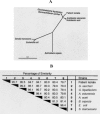A novel bacterium associated with lymphadenitis in a patient with chronic granulomatous disease
- PMID: 16617373
- PMCID: PMC1435791
- DOI: 10.1371/journal.ppat.0020028
A novel bacterium associated with lymphadenitis in a patient with chronic granulomatous disease
Abstract
Chronic granulomatous disease (CGD) is a rare inherited disease of the phagocyte NADPH oxidase system causing defective production of toxic oxygen metabolites, impaired bacterial and fungal killing, and recurrent life-threatening infections. We identified a novel gram-negative rod in excised lymph nodes from a patient with CGD. Gram-negative rods grew on charcoal-yeast extract, but conventional tests could not identify it. The best 50 matches of the 16S rRNA (using BLAST) were all members of the family Acetobacteraceae, with the closest match being Gluconobacter sacchari. Patient serum showed specific band recognition in whole lysate immunoblot. We used mouse models of CGD to determine whether this organism was a genuine CGD pathogen. Intraperitoneal injection of gp91(phox -/-) (X-linked) and p47 (phox -/-) (autosomal recessive) mice with this bacterium led to larger burdens of organism recovered from knockout compared with wild-type mice. Knockout mouse lymph nodes had histopathology that was similar to that seen in our patient. We recovered organisms with 16S rRNA sequence identical to the patient's original isolate from the infected mice. We identified a novel gram-negative rod from a patient with CGD. To confirm its pathogenicity, we demonstrated specific immune reaction by high titer antibody, showed that it was able to cause similar disease when introduced into CGD, but not wild-type mice, and we recovered the same organism from pathologic lesions in these mice. Therefore, we have fulfilled Koch's postulates for a new pathogen. This is the first reported case of invasive human disease caused by any of the Acetobacteraceae. Polyphasic taxonomic analysis shows this organism to be a new genus and species for which we propose the name Granulobacter bethesdensis.
Conflict of interest statement
Figures







Comment in
-
The Acetobacteraceae: extending the spectrum of human pathogens.PLoS Pathog. 2006 Apr;2(4):e36. doi: 10.1371/journal.ppat.0020036. PLoS Pathog. 2006. PMID: 16652172 Free PMC article. No abstract available.
References
-
- Segal BH, Leto TL, Gallin JI, Malech HL, Holland SM. Genetic, biochemical, and clinical features of chronic granulomatous disease. Medicine (Baltimore) 2000;79:170–200. - PubMed
-
- Winkelstein JA, Marino MC, Johnston RB, Jr, Boyle J, Curnutte J, et al. Chronic granulomatous disease. Report on a national registry of 368 patients. Medicine (Baltimore) 2000;79:155–169. - PubMed
-
- Dorman SE, Guide SV, Conville PS, DeCarlo ES, Malech HL, et al. Nocardia infection in chronic granulomatous disease. Clin Infect Dis. 2002;35:390–394. - PubMed
-
- Guide SV, Stock F, Gill VJ, Anderson VL, Malech HL, et al. Reinfection, rather than persistent infection, in patients with chronic granulomatous disease. J Infect Dis. 2003;187:845–853. - PubMed
-
- Sereti I, Holland SM. Disseminated nocardiosis in a patient with X-linked chronic granulomatous disease and human immunodeficiency virus infection. Clin Infect Dis. 2001;33:235–239. - PubMed
Publication types
MeSH terms
Substances
Associated data
- Actions
- Actions
Grants and funding
LinkOut - more resources
Full Text Sources
Other Literature Sources
Medical
Molecular Biology Databases
Research Materials

